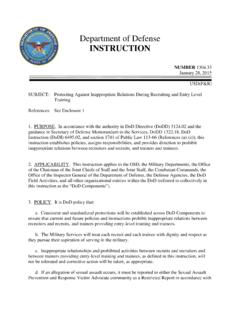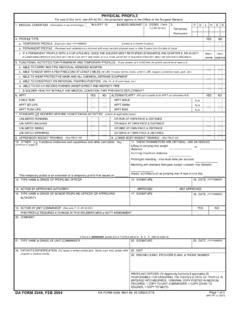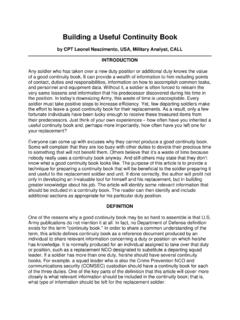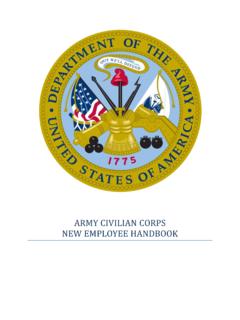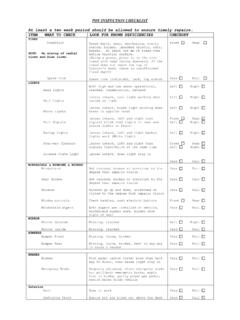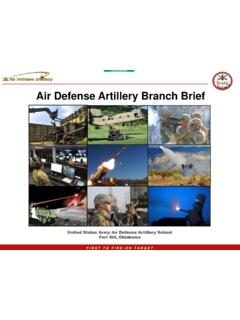Transcription of Building a Useful Continuity Book - Fort Sill
1 Building a Useful Continuity Book by CPT Leonel Nascimento, USA, Military Analyst, CALL INTRODUCTION Any soldier who has taken over a new duty position or additional duty knows the value of a good Continuity book. It can provide a wealth of information to him including points of contact, duties and responsibilities, information on how to accomplish common tasks, and personnel and equipment data. Without it, a soldier is often forced to relearn the very same lessons and information that his predecessor discovered during his time in the position. In today s downsizing Army, this waste of time is unacceptable. Every soldier must take positive steps to increase efficiency. Yet, few departing soldiers make the effort to leave a good Continuity book for their replacements.
2 As a result, only a few fortunate individuals have been lucky enough to receive these treasured items from their predecessors. Just think of your own experiences how often have you inherited a Useful Continuity book and, perhaps more importantly, how often have you left one for your replacement? Everyone can come up with excuses why they cannot produce a good Continuity book. Some will complain that they are too busy with other duties to devote their precious time to something that will not benefit them. Others believe that it's a waste of time because nobody really uses a Continuity book anyway. And still others may state that they don t know what a good Continuity book looks like. The purpose of this article is to provide a technique for preparing a Continuity book that will be beneficial to the soldier preparing it and Useful to the replacement soldier and unit.
3 If done correctly, the author will profit not only in developing an invaluable tool for himself and his replacement, but in Building greater knowledge about his job. The article will identify some relevant information that should be included in a Continuity book. The reader can then identify and include additional sections as appropriate for his particular duty position. DEFINITION One of the reasons why a good Continuity book may be so hard to assemble is that Army publications do not mention it at all. In fact, no Department of Defense definition exists for the term " Continuity book." In order to share a common understanding of the term, this article defines Continuity book as a reference document produced by an individual to share relevant information concerning a duty or position on which he/she has knowledge.
4 It is normally produced for an individual assigned to take over that duty or position, such as a replacement NCO designated to substitute a departing squad leader. If a soldier has more than one duty, he/she should have several Continuity books. For example, a squad leader who is also the Crime Prevention NCO and communications security (COMSEC) custodian should have a Continuity book for each of the three duties. One of the key parts of the definition that this article will cover more closely is what relevant information should be included in the Continuity book; that is, what type of information should be left for the replacement soldier. TECHNIQUES AND PROCEDURES The individual preparing the Continuity book should keep several things in mind during its development: Start Now and Keep Revising It.
5 The Continuity book should not be put together the week before the replacement takes over. In fact, the departing soldier should begin assembling it when he first assumes his position. This will allow him to begin recording Continuity information during his time in that position and will ensure that the data in the book is accurate and detailed. Moreover, the developmental process involved in putting together the document will greatly increase the author s own familiarity with his duty position. Use It Daily. The author should assemble the book with an eye to making it relevant and Useful for himself. He will know he has achieved this when he refers to it to accomplish routine activities. This technique has two advantages. First and foremost, the soldier developing the document can use it as a handy reference.
6 A second advantage, one that is important to both the unit and the replacement soldier, is that the book is tested by the author on a daily basis for relevance and usefulness. Make the Continuity Book One of the Goals and Objectives in the Author s NCOER Checklist or OER Support Form. A soldier and the soldier s rater should agree on the importance of developing the document during the rating period. This ensures that the author is both afforded the time and given the credit for producing it. Make the Document Revision-Friendly. With the current ease of accessibility to computers in both the workplace and at home, soldiers should assemble information for the Continuity book using computers. This allows the author to quickly update old information.
7 Additionally, he/she can save the data on computer disks. This allows a replacement to further revise and update the information to pass on to future replacements. However, remember to save the data in a manner which allows the replacement soldier to access it. Normally, the optimal method of doing this is to save it on a computer disk using a software program (pay attention to the version) that the replacement can access using the computer at the unit. In undertaking the task of constructing a Continuity book, the author must decide what relevant information he/she should include in the book. Of greatest importance, the book should include information that cannot be found anywhere else, such as standing operating procedures (SOPs) and policy letters.
8 The author also wants to ensure that successful techniques in accomplishing key tasks are listed and shared with the replacement soldier. Some Useful sections of a Continuity book are listed below: Table of Contents - This page should be at the very beginning of the document to give the reader a quick reference to all the information contained within the book. Of course, the author should complete this section only after he has put together the rest of the Continuity book. Duty Appointment Orders - These orders often state the references that the appointed individual will use to carry out his duties. Normally, the unit adjutant or company executive officer, in the case of a company-level duty appointment, publishes the appointment orders. References - This section lists the publications that the author found Useful in effectively performing his job.
9 For some positions, such as additional duties, the number of references may be few. However, for positions such as company commander, the list of references could be lengthy. In this case, the departing officer should list only the references that he believes is especially Useful . In any event, the replacement can use the reference guide as a reading list to learn the specifics of his duties and responsibilities. Duties and Responsibilities - The author should provide a job description of the duty position. If applicable, he can enclose a copy of his Officer Evaluation Report Support Form (DA 67-9) with Part IV (Rated Officer significant duties and responsibilities and major performance objectives) completed or Noncommissioned Officer Evaluation Report (NCOER) (DA 2166-7) with Part III (Duty Description) filled out.
10 Mission Statement - The Continuity book should contain the unit s mission statement, as well of those of the next two higher headquarters. This provides the replacement a reference on how his new job fits into the overall success of the unit mission. Mission Essential Task List (METL) - The departing soldier should list the collective tasks of his section and how they support his higher echelon s METL. Common Tasks - This is one of the key sections of the Continuity book. It provides step-by-step instruction on how to accomplish key common tasks for that duty position. This can be done with worded instructions or through pictures and diagrams, such as flow charts. If the steps are already listed in unit standing operations procedures (SOP), simply refer to the appropriate section of the document.

